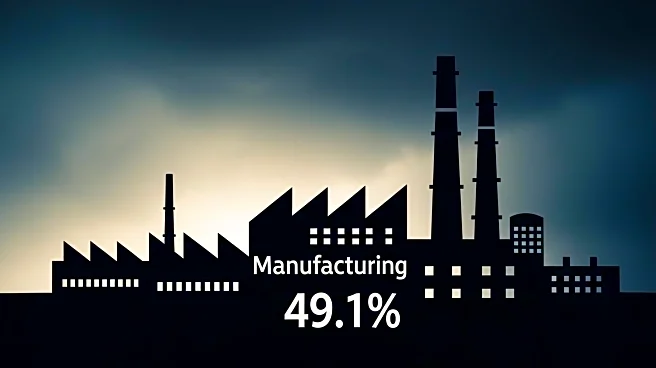What's Happening?
The U.S. manufacturing sector experienced contraction for the seventh consecutive month in September, according to the latest ISM Manufacturing PMI report. The Manufacturing PMI registered 49.1 percent, a slight increase from August's 48.7 percent. Despite this, the overall economy has been expanding for 65 months, except for a brief contraction in April 2020. The New Orders Index fell to 48.9 percent, indicating a decline in new orders, while the Production Index rose to 51 percent. The Prices Index, although still in expansion, decreased to 61.9 percent. The report highlights ongoing challenges in the manufacturing sector, with the Employment Index at 45.3 percent, suggesting continued workforce management issues.
Why It's Important?
The continued contraction in the U.S. manufacturing sector signals potential challenges for the broader economy. Manufacturing is a critical component of the U.S. economy, and its performance can influence economic growth, employment, and trade balances. The decline in new orders and inventories suggests potential future slowdowns in production, which could impact supply chains and employment. The report indicates that 67 percent of the manufacturing sector's GDP contracted in September, with significant portions experiencing strong contraction. This trend could affect related industries and economic stakeholders, including suppliers, workers, and investors.
What's Next?
The manufacturing sector's future performance will depend on various factors, including demand recovery, supply chain stability, and economic policies. Stakeholders will likely monitor upcoming economic indicators and policy decisions that could influence manufacturing activity. Companies may need to adjust strategies to manage workforce and production levels effectively. The sector's recovery will be crucial for sustaining overall economic growth and stability.
Beyond the Headlines
The contraction in manufacturing raises questions about the long-term competitiveness of the U.S. manufacturing sector. Factors such as technological advancements, trade policies, and global competition could shape the sector's future. Companies may need to invest in innovation and efficiency to remain competitive. Additionally, the sector's performance could influence political and economic discussions, particularly regarding trade and industrial policies.











